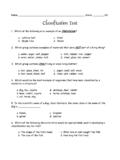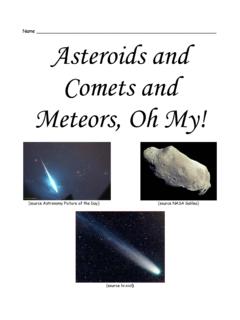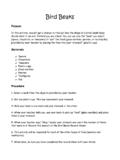Transcription of Name Constellations Workbook - Mr. Hill's Science …
1 name _____ Constellations Workbook THE STARS OF SPRING Follow the Arc Copyright 1997 by Bob Martino - All rights reserved About Constellations (modified from a NASA/Amazing Space Student Background Reading) - 1 - Look up at the sky on a clear night. You will see vast patterns of bright stars. Close your eyes and think about the shapes of these patterns. Do they remind you of people, or animals, or mythological beings? Ancient astronomers imagined they saw people, animals, and mythological beings in the sky. They called them Constellations . Constellation Myths Constellation myths are ancient stories about the gods, heroes, and mythological creatures (serpents, dragons, and flying horses) featured in the Constellations .
2 The Greeks and Romans created the stories for their Constellations . Other societies had their own myths for the stars. The stories were part of their religions, helping them to explain everyday events, such as the seasons. These stories usually have a hero, who was given an honorary place in the sky, as either a reward or a tribute. Most of the Constellations in the Southern Hemisphere are more modern. European explorers identified and named these Constellations . They are not usually associated with myths . Constellations and the Star Patterns They re Based On Currently, the entire sky has been divided into 88 Constellations .
3 A simple star pattern lies at the heart of each constellation. The stars in these patterns may appear to be close to each other, but they are often very far apart. Often, there is little resemblance between the constellation and what it represents. For example, consider the Northern Hemisphere s winter constellation, Orion, the Hunter. The star pattern four bright stars at the corners of a trapezoid and three stars in a row near the center doesn t look much like a person. The ancients used a lot of imagination when they created the Constellations . The History of Constellations Many of our modern Constellations come from the ancient Greeks, but they were not the first to see patterns among the stars.
4 Historians believe that the ancient Babylonians and Sumerians invented many of the Constellations . They passed the tradition on to the ancient Egyptians and Greeks. Arabs learned of the Greeks writings on astronomy and translated them into Arabic. Greeks had named their stars based on the star s position in a constellation, but Arabs began naming individual stars for people. Later, the Romans translated - 2 - the Arabic writings into Latin. We now have Arabic names (Zubenelgenubi) for stars in Greek Constellations that bear Latin (Ursa Major) names! Original Uses for the Constellations Ancient farmers may have used the stars to tell them when to plant and harvest their crops.
5 Since some Constellations are only visible at certain times of the year, their appearance can reveal the month. Some historians think the constellation myths were invented to help the farmers remember the Constellations . Throughout history, the stars have also been used for navigation. Travelers have historically relied on the North Star, Polaris, to mark their way. Polaris is the last star at the end of the handle of the asterism1 of the Little Dipper, in the constellation of the Little Bear. Due to Earth s rotation, the stars appear to move across the night sky. But, Polaris is located above Earth s North Pole, so it doesn t appear to change position through the night.
6 Modern Uses for the Constellations Constellations give modern-day sky watchers a means of keeping track of the many bright stars in the sky. By looking for groups of stars in a particular pattern, professional and amateur astronomers can locate specific stars within the group. For example, many people can pick out the trapezoidal winter star pattern known as Orion. Once they have found Orion, they can find Betelgeuse (Orion s left shoulder) and Rigel (Orion s right foot), two of the brightest stars in this region of the sky. Constellations are also used to locate other objects, such as galaxies and nebulae (areas where gas and dust are clustered).
7 1 The term asterism is used here to indicate a subset of the stars in a constellation that make a separate, recognized pattern of their own. The Little Dipper is such a group of stars, found within the Little Bear, one of the 88 Constellations . The stars making up the Big Dipper are another asterism, falling within the constellation of the Great Bear. - 3 - Constellations and the World s Cultures Many cultures have identified star patterns, but rarely do these patterns correspond to those of other cultures. One of the patterns in the northern sky that many cultures have recognized is the asterism1 called, in the , the Big Dipper.
8 In southern France, it is called a saucepan. In Britain, it s the plough. The Mayans called it Seven Macaw, a parrot. The Hindus saw seven wise men. The Micmac Indians of Maritime Canada, and other North American Indians saw a bear (the part we see as the bowl of the dipper), with hunters tracking it (the handle). The runaway slaves called it the drinking gourd and followed it north to freedom. The Big Dipper became a symbol of freedom. It is unusual for so many cultures to pick out the same set of stars. Perhaps it is because all seven stars are very bright. About Constellations Student Reading Worksheet 1.
9 What do we CALL patterns in the sky? _____ 2. What ARE constellation myths? _____ _____ 3. Which Constellations ARE NOT usually associated with myths? _____ 4. There are HOW MANY Constellations ? _____ 5. Describe the LOCATION of the stars in a constellation (near to each other, far away, in different parts of the sky, etc.). _____ _____ - 4 - 6. Who INVENTED many of our Constellations ? _____ 7. How did farmers USE Constellations ? _____ _____ 8. Travelers have historically relied on the _____ to mark their way. 9. How do modern sky watchers USE the stars?
10 _____ _____ _____ 10. Constellations are also USED to find .. a. b. 11. In the United States, this asterism is called the Big Dipper. List OTHER names of this constellation. a. b. c. d. e. f. 12. What was the SIGNIFICANCE of the drinking gourd ? _____ _____ - 5 - 13. Describe the various USES of Constellations . _____ _____ _____ 14. Why did most societies DEVELOP myths surrounding the Constellations ?











